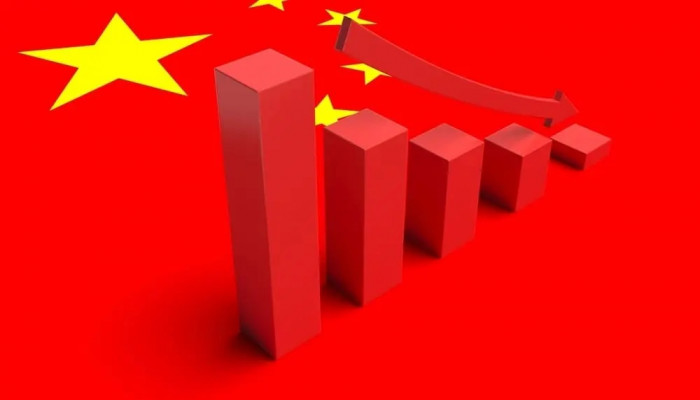‘Socialism with Chinese Characteristics’: A Drag on Chinese Economy
- In Military & Strategic Affairs
- 10:56 PM, Jan 17, 2024
- LT GEN P R SHANKAR (Retd)
China’s phenomenal rise was due to two factors – exports of manufacturing goods and debt-fuelled investment in infrastructure. Its huge manufacturing capacity made it the factory of the world and the starting point of most supply chains. Kitchen knives to industrial machinery from China found their way to every corner of the earth. Its debt-fuelled investment propelled property and infrastructure created a glitzy China which was the world’s envy. Those were heady days of double-digit growth.
As China was galloping through them, everyone knew the growth was lopsided but the momentum was with it. The Chinese consumption and services sectors were weak despite all the hype of growth. Someday it would bite them. But who cared? One fine day, Xi had the ultimate solution in the BRI! The tentacles of the octopus like BRI, reached most corners of the earth. It was to sustain an outward flow of exports and services to create profit. The inward flow of cheap raw materials was to keep feeding its hungry manufacturing vortex. China was unstoppable in its bid for global domination.
It was a runaway train with Xi Jinping and his band of wolf warriors at the helm. They wanted to grab the world by the scruff of its neck and turn it into their middle kingdom fief. They threatened the world, especially the affluent part of it. People who previously welcomed China’s rise were now completely wary about it.
The red lights for this runaway train lit up with the arrival of the homegrown Wuhan virus. Look back. The ‘Germs of Wuhan’ broke globalisation and created geopolitical discord. The world deglobalized into islands seeking self-sufficiency through derisking/decoupling from China. It broke the mercantilism of the BRI. People in the USA, India, EU, Australia, Japan, S Korea and many more nations sought self-sufficiency in manufacturing away from China. It just disrupted most Chinese flows. The external part of the dual circulation model started going down. The underwhelming internal circulation came into the picture.
Suddenly China realised that the consumption by the Chinese mattered more if the train was to maintain its speed. The runaway train was however being handbraked by two entities – the ordinary Chinese people and the extraordinary Chinese communists. The famous social contract between the people of China and the communists –‘ you give us your liberty and we will give you prosperity’ – kept them in separate spheres of existence for a long time.
Till the time that each did not interfere with the other, the magic worked. Unfortunately for both the magic has run its course. They have started interfering in each other’s spheres. Collectively they have put the hard brakes on the run-away train.
The Communists need the Chinese people to consume. The Communists are forcing, coercing and pleading alternately with them to consume. Something which they never had to do before. However, the Chinese are not biting the bullet. They are simply refusing to consume. The refusal to consume is because they are losing jobs and suffering pay cuts. When social media platforms are flooded with posts on joblessness and the hopelessness of job hunting the Chinese are wondering as to why their government feels that they have money to spend.
“The stock market and real estate are in a slump. Investments are shrinking. No one dares to spend. Economy is not doing well. Everyone is worried about the future, so why should I spend money?” is what many Chinese think. This is where history comes in. The elder Chinese are frugal by nature since they have lived through years of hunger and famines. They have lived through poverty. The Chinese have never had money to splurge.
If they have one fear as a nation, it is the fear of hunger! Now that is a powerful emotion. When Xi Jinping goes around talking of protecting the ‘iron rice bowl’ he is just fuelling that fear of hunger and the need to save more for the rainy days ahead. The Chinese culture of saving and not spending is reverting to normal as the social contract is failing after three decades of unnatural opening up purse strings.
To save the economy, the Communists are trying everything short of a direct transfer stimulus. They know that if money is put directly into a Chinese pocket, it will go directly into a bank and not trigger consumption. After all, the communists are also Chinese! They know themselves the best. The hard reality is that unless people are made affluent, they cannot consume, nor will the social contract survive! That is what Deng Xiaoping who made this contract and his successors Jiang Zemin and Hu Jintao attempted – to eventually make China an affluent consuming nation. It was only then that China became an economic superpower.
Every two-bit economist in China knows that. However, when people are affluent, they want freedom. When Xi Jinping strode into power, he realized that the CCP was on the verge of losing control and eventually its power. Xi Jinping reversed the opening-up and reform tide and turned on the screws of communism. Now the communists are snared in their own web. No communist country has been rich. In fact, where people grow rich, communism vanishes. If people become rich, the CCP will become as irrelevant as the CPI in Bengal!
As a result, people in communist China cannot be rich and they have to be kept in poverty if the CCP is to remain in power. What Xi Jinping is attempting is to create a nation of poor people in a rich state. That is unnatural. Very simply because it is the people who make the state rich. All confusing? The fact of the matter is that Xi Jinping and the CCP have a choice. A prosperous China with prosperous people means CCP out of power. CCP in power means poorer people in a poorer China. That is the general direction of future China!
However, Xi Jinping and his band of wolf warriors are a hardy lot and wont keel over. They are trying to trigger consumption through investment – not in property but in manufacturing and infrastructure to create jobs. They are hoping the jobs created will trigger a wave of consumption. The problem for the Chinese private businesses is that where will their manufacturing output sell in a world riven by wars, choke point politics, supply chain and energy disruptions, protectionism, inflation and climate change? There are other problems.
The private sector in China has a more than 60% share of China’s GDP. However, it is a singed cat low on confidence due to Xi’s draconian coronavirus lockdowns and sweeping crackdowns which broke internet giants, gaming and private tutoring in recent years. Once culled by common prosperity, the private sector does not trust the government's overtures. No rich businessman earns for the poor. Is that not a truism? No wonder that the private investment has fallen further in 2023. Obviously, China’s 31-point action plan to revive private industry has not worked. Xi Jinping is searching for the 32nd point!
Coming to the other issue. The less said about the latest debt-fuelled infrastructure push the better. Looming on the horizon for China’s infrastructure push is an additional 2500 km of high-speed rails. This is additional capacity in an area that has surplus capacity and low usage already! All this will create more ghost trains, ghost roads, ghost parks and ghost public utilities to complement its ghost cities. Talking of debt.
Congratulations to China for finally overtaking the US in debt-to-GDP terms! As per Michael Pettis, “The surge in Chinese debt is not itself the problem but rather a symptom of the problem. The real problem is the cumulative but unrecognised losses associated with the misallocation of investment over the past decade into the excess property, infrastructure and increasingly, manufacturing”. Communist China is laying out high-speed rails to slow down!
Step back and ponder. China faces some severe contradictions. It must reduce debt while stimulating growth. It desires capitalistic market growth in an environment of socialism with Chinese characteristics (whatever they are). People need a stimulus but the need is financial discipline. Both these have to be under strict state control. Xi Jinping talks of common prosperity to flatten wealth inequality but needs the private sector which generates greater inequality.
China needs the innovation and drive of the private sector while cutting its successful private entrepreneurs down to size. China’s industry depends on highly polluting coal energy when the need is to reduce pollution. As if all this is not enough its demography is declining at the fastest rate in human history. As its economy weakens, it continues to spend without care on its unproven military and risky high technologies. All these point to one thing. Further stumbles and accidents with Chinese characteristics are around the corner. They will sink China further.
To put a point into its correct focus. Robotics and advanced technologies can offset a human workforce resulting from a demographic decline. It might lead to enhanced production and manufacturing. However, it will not lead to enhanced consumption. Robots don’t consume. Humans do.
References
- https://www.scmp.com/economy/china-economy/article/3247037/chinas-capital-rolls-out-no-no-list-officials-dealing-beijings-entrepreneurs-more-needed-tackle-sore?utm_source=twitter&utm_campaign=3247037&utm_medium=share_widget
- https://www.reuters.com/world/china/chinas-home-sales-during-new-year-holiday-fall-26-compared-with-2023-2024-01-02/
- https://www.ft.com/content/630f828c-ce4b-4f41-a867-9593bfaf0528
- https://www.ft.com/content/630f828c-ce4b-4f41-a867-9593bfaf0528
- https://www.bloomberg.com/news/articles/2024-01-02/china-s-bear-market-lures-investors-betting-on-rally?utm_source=website&utm_medium=share&utm_campaign=twitter
- https://www.bloomberg.com/news/articles/2024-01-02/china-injects-50-billion-into-policy-banks-in-financing-push?utm_source=website&utm_medium=share&utm_campaign=twitter
- https://www.scmp.com/economy/china-economy/article/3236158/can-chinas-high-speed-railways-get-its-economy-back-track
Image source: Current Affairs-Adda247







Comments